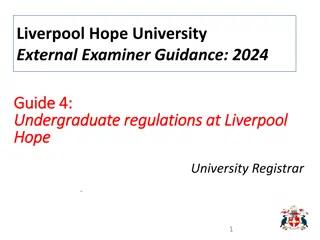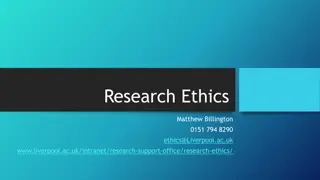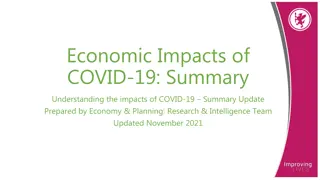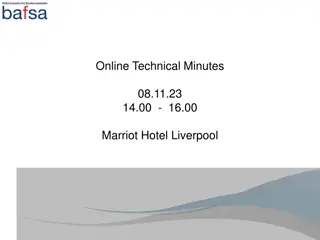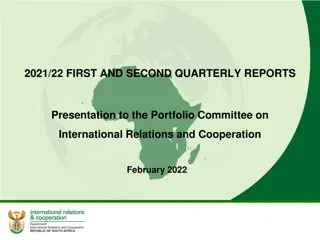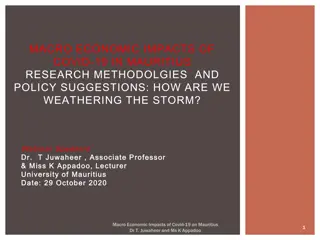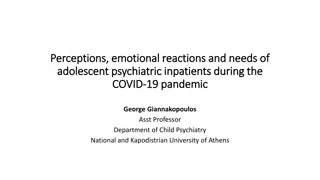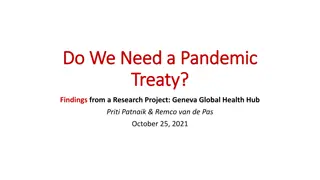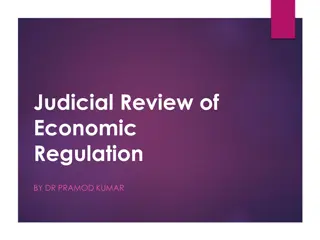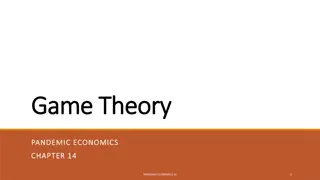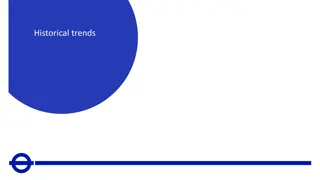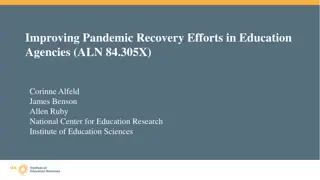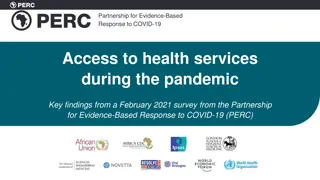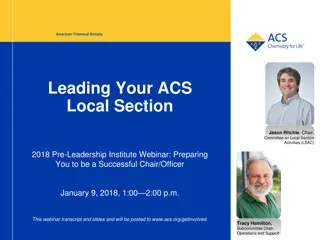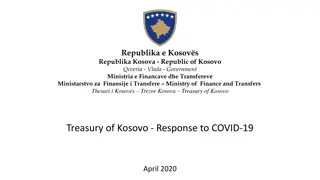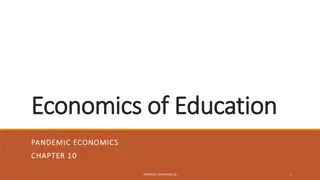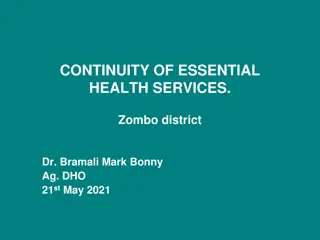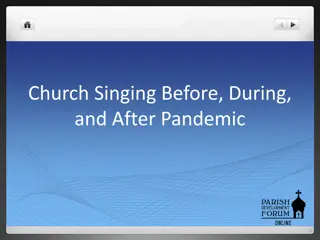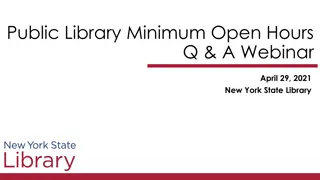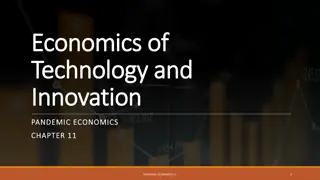Economic Impact of the Pandemic: Insights from University of Liverpool Webinar
Explore the potential economic scarring caused by the pandemic, as discussed in an online webinar by the University of Liverpool Management School featuring Jonathan Haskel from Imperial College Business School and the Bank of England. The presentation delves into GDP forecasts, the concept of economic output, factors influencing productivity, and the impacts on investment during COVID-19, shedding light on the road ahead for the economy.
Download Presentation

Please find below an Image/Link to download the presentation.
The content on the website is provided AS IS for your information and personal use only. It may not be sold, licensed, or shared on other websites without obtaining consent from the author. Download presentation by click this link. If you encounter any issues during the download, it is possible that the publisher has removed the file from their server.
E N D
Presentation Transcript
Will the pandemic scar the economy? Online webinar at the University of Liverpool Management School 19 July 2021 Jonathan Haskel @haskelecon Imperial College Business School, and Bank of England Full text of speech available on Bank of England Website Views are my own.
Where we are Bank of England GDP forecasts Sources: ONS and Bank of England
Where are we going? Bank of England GDP forecasts The question: How much level scarring relative to pre-pandemic GDP? Sources: ONS and Bank of England. Note: from 2023 onwards, the January 2020 MPR forecast is extrapolated using quarterly growth rates similar to those in the forecast for 2022.
What is economic output? ? = ? ? ,? ,? ? ,? ? ? = ? ,? ? ? ? 1. Productivity: Human capital L Tangible capital K Stock of machines, buildings and vehicles Intangible capital R Stock of paid-for knowledge and creativity, E.g. artistic originals, code, drug formulae, design, know-how for supply chains Economic structure, S Share of industries high/low productivity Total Factor Productivity A State of generally available knowledge enabling inputs to be used better e.g. most airlines use speedy boarding Education, skills and training 2. Hours worked H Depends on population, participation rate in labour force, unemployment rate Role of furlough ? during the pandemic ? ??? ? = ??? ???? 1 ? ?
How might the pandemic induce scarring? = ? ? ,? ,? ? ,? ? ? ??? ,? ??? ???? 1 ? ? ? ? 1. Lower Productivity: Human capital L Lower L due to loss of years of education, training Tangible capital K Fewer machines, buildings and vehicles Intangible capital R Lower investment in knowledge creation : science, software, the arts Economic structure, S Share of industries high/low productivity changes R punches above its weight : R in an industry helps other sectors (spillovers). So scarring particularly depends on R 2. Fewer hours worked H Participation falls Unemployment rises e.g. mismatch
Investment during Covid: intangible investment relatively resilient Business investment components Intellectual Property Products are: a. R&D, b. software and databases, c. literary and artistic originals Source: ONS 1. Business investment fell by 12% in 2020 2. concentrated in buildings and tangible capital 3. intangible investment held up 3. Resilience of intangibles limits scarring
How much scarring in the medium term? Productivity. Source: author s calculations 1. Scarring from L due to loss of experience
How much scarring in the medium term? Productivity. Source: author s calculations 1. Scarring from L due to loss of experience 2. For capital: use May MPR forecast for total investment, then share out to different capital assets. Try different shares 3. Tangible capital: always scarring
How much scarring in the medium term? Productivity. Source: author s calculations 1. Scarring from L due to loss of experience 2. For capital: use May MPR forecast for total investment, then share out to different capital assets. Try different shares 3. Tangible capital: always scarring 4. Intangible capital 1. high share of R (2020 level), no/negative scarring , and higher output by 2024 2. if investment shares back to past levels, scarring
How much scarring in the medium term? Productivity. Source: author s calculations 1. Scarring from L due to loss of experience 2. For capital: use May MPR forecast for total investment, then share out to different capital assets. Try different shares 3. Tangible capital: always scarring 4. Intangible capital 1. high share of R (2020 level), no/negative scarring , and higher output by 2024 2. if investment shares back to past levels, scarring 5. Overall scarring estimate in the range of -1.5 to 1.5 percent [Bank of England May MPR forecast: -1.25%]
Might productivity get better not worse? Working from home Shock absorber: used potential capital at home Concentrated: Dec 2020: 80% Info/comms, 10% accommodation and food Productivity evidence? Mixed Call centre workers: prod rose Patent examiners: prod fell Does greater productivity at home mean more WFH? Digitalisation
Will digitalisation boost productivity? Back to intangibles . Digitalisation and automation during Covid-19 Example: a oximeter Source: McKinsey Global Business Executive Survey, July 2020
Scarring in the labour market: hours Depends on the evolution of Population Participation rates, especially of over 50s (25% of decline in activity, 20% of furl) Unemployment and mismatch
Scarring in the labour market: mismatch Mismatch high if: Vacancies and unemployed are Widely spread by region, industry (= lots of thin labour markets) In the wrong industry/region (= wrong skills/location) If mismatch is high then inflation is high labour market not matching Workers aren t available Wages rise, prices chase wages, wage/price spiral What measures would indicate mismatch? U and V spread widely and/or different industries Vacancies took a longer time to fill Full time furloughed workers aren t getting jobs, only partial furloughed are. What do the data say?
Labour mismatch: vacancy duration, full v partial furlough Vacancies are being filled quickly Partially and fully furloughed falling Days job advert remains online Avgs: 25days, 22, 18. Furlough share Source: Indeed. Note: Duration measures the number of days a job posting is visible on the Indeed website. Source: HMRC CJRS. Note: Monthly figures refer to the end of month. Percentages indicate the share of total furlough for that type. These will not sum to 100 due to unclassified types of furlough in the dataset. Source: www.indeed.co.uk
Labour mismatch: unemployment and vacancies Mismatch is falling (data to May) Note: Data to May 2021. Estimates of sectoral mismatch are based on Sahin et al (2014). The blue line is the standard approach using official unemployment and vacancies. The green line adds those on furlough by sector to the unemployment series. The pink line adds those on furlough by sector who are searching for work to the unemployment series. Furlough figures are based on data to May.
Labour mismatch: vacancy spreads to 9th July 2021 ONS (lower line) and Adzuna vacancy spreads Source: ONS and Adzuna Note: ONS June vacancy snapshot was taken on 4 June. Weekly Adzuna online vacancy data to 9 July.
Does more supply mean run the economy hot? 1. The output gap: ?????? ??? =? ? ? 2. More y* means output gap rises => less inflation => loose policy forward-looking firms, consumers spend now in anticipation of better times => more inflation => tight policy
Running the economy hot: model simulations Anticipated v unanticipated shocks 1. More supply under 2 scenarios: Now, but unanticipated (dashed line) In future, but anticipated now (solid line) 2. Inflation and policy rate ? No anticipation: inflation low => looser policy Anticipation: inflation high = > tighter policy Note: Figure plots the simulated responses for selected variables under two scenarios in a medium scale DSGE model based on the Bank of England s own forecasting model Compass (2013). The unanticipated scenario shows the response to an unanticipated one time one percent increase in TFP. The anticipated scenarios shows the response when the increase in TFP is correctly anticipated by households and businesses four quarters ahead. Inflation is the difference in percentage points from the target. The policy rate is the change in the level of the short-term interest rate set by the Central Bank under a Taylor rule. Output and productivity are percentage differences from a counterfactual of no change in TFP.
Tight policy is not the right policy 1. Forward-looking scenario seems relevant: Government roadmap Inflation at 2.5% in June, input prices rising 2. But I m not in favour of tightening policy yet: Base effects : mechanical rise of annual inflation from April in 2021 as fuel prices collapsed in March 2020 by 60%. Half of CPI rise to end year likely due to energy prices Rising goods prices are because we haven t been able to consume services Labour market signals falling mismatch We have not recovered yet: Delta variant R=1.5 Fiscal tightening as Covid measures withdrawn 3. Risk management: lean against pre-emptive tightening
Output losses during Covid Memo Productivity Hours Relative to 2019q4 levels Population aged 16+ (POP) 2a Participation rate = LF/POP (PART) 2b Employment share of labour force 2c Average hours (H/N) 2d Employment share excl. furlough 5 (2c-4) Output Unemployment rate, % (u) Furlough* share of labour force (f) Average hours excl. furlough Total Within Reallocation Total (H) 0 1 1a 1b 2 3 4 6 Column (1*2) (1a*1b) (2a*2b*2c*2d) or (2a*2b*5*6) ((2 / (2a*2b*5)) 2019 Q4 1.00 1.00 1.00 1.00 1.00 1.00 1.00 1.00 1.00 3.8 0.0 1.00 1.00 2020 Q1 0.97 0.99 0.98 1.01 0.98 1.00 1.00 1.00 0.98 4.0 2.1 0.98 1.00 2020 Q2 0.78 0.97 0.89 1.09 0.80 1.00 0.99 1.00 0.81 4.1 30.4 0.68 1.18 2020 Q3 0.91 1.04 1.03 1.00 0.88 1.00 0.99 0.99 0.89 4.8 12.4 0.86 1.03 2020 Q4 0.93 0.99 0.97 1.02 0.93 1.01 0.99 0.99 0.95 5.1 9.9 0.88 1.06 2021 Q1 0.91 1.00 0.98 1.03 0.91 1.01 0.99 0.99 0.92 4.8 14.1 0.84 1.08 Source: ONS, HMRC & author s calculations 1. Output loss of 9%
Output losses during Covid Memo Productivity Hours Relative to 2019q4 levels Population aged 16+ (POP) 2a Participation rate = LF/POP (PART) 2b Employment share of labour force 2c Average hours (H/N) 2d Employment share excl. furlough 5 (2c-4) Output Unemployment rate, % (u) Furlough* share of labour force (f) Average hours excl. furlough Total Within Reallocation Total (H) 0 1 1a 1b 2 3 4 6 Column (1*2) (1a*1b) (2a*2b*2c*2d) or (2a*2b*5*6) ((2 / (2a*2b*5)) 2019 Q4 1.00 1.00 1.00 1.00 1.00 1.00 1.00 1.00 1.00 3.8 0.0 1.00 1.00 2020 Q1 0.97 0.99 0.98 1.01 0.98 1.00 1.00 1.00 0.98 4.0 2.1 0.98 1.00 2020 Q2 0.78 0.97 0.89 1.09 0.80 1.00 0.99 1.00 0.81 4.1 30.4 0.68 1.18 2020 Q3 0.91 1.04 1.03 1.00 0.88 1.00 0.99 0.99 0.89 4.8 12.4 0.86 1.03 2020 Q4 0.93 0.99 0.97 1.02 0.93 1.01 0.99 0.99 0.95 5.1 9.9 0.88 1.06 2021 Q1 0.91 1.00 0.98 1.03 0.91 1.01 0.99 0.99 0.92 4.8 14.1 0.84 1.08 Source: ONS, HMRC & author s calculations 1. Output loss of 9% 2. Within-firm productivity fell by 2% but offset by increased across-sector productivity ( batting average effects)
Output losses during Covid Memo Productivity Hours Relative to 2019q4 levels Population aged 16+ (POP) 2a Participation rate = LF/POP (PART) 2b Employment share of labour force 2c Average hours (H/N) 2d Employment share excl. furlough 5 (2c-4) Output Unemployment rate, % (u) Furlough* share of labour force (f) Average hours excl. furlough Total Within Reallocation Total (H) 0 1 1a 1b 2 3 4 6 Column (1*2) (1a*1b) (2a*2b*2c*2d) or (2a*2b*5*6) ((2 / (2a*2b*5)) 2019 Q4 1.00 1.00 1.00 1.00 1.00 1.00 1.00 1.00 1.00 3.8 0.0 1.00 1.00 2020 Q1 0.97 0.99 0.98 1.01 0.98 1.00 1.00 1.00 0.98 4.0 2.1 0.98 1.00 2020 Q2 0.78 0.97 0.89 1.09 0.80 1.00 0.99 1.00 0.81 4.1 30.4 0.68 1.18 2020 Q3 0.91 1.04 1.03 1.00 0.88 1.00 0.99 0.99 0.89 4.8 12.4 0.86 1.03 2020 Q4 0.93 0.99 0.97 1.02 0.93 1.01 0.99 0.99 0.95 5.1 9.9 0.88 1.06 2021 Q1 0.91 1.00 0.98 1.03 0.91 1.01 0.99 0.99 0.92 4.8 14.1 0.84 1.08 Source: ONS, HMRC & author s calculations 1. Output loss of 9% 2. Within-firm productivity fell by 2% but offset by increased across-sector productivity ( batting average effects) 3. Fall of 9% in total hours worked almost entirely accounted for by fall in average number of hours worked per worker
Output losses during Covid Memo Productivity Hours Relative to 2019q4 levels Population aged 16+ (POP) 2a Participation rate = LF/POP (PART) 2b Employment share of labour force 2c Average hours (H/N) 2d Employment share excl. furlough 5 (2c-4) Output Unemployment rate, % (u) Furlough* share of labour force (f) Average hours excl. furlough Total Within Reallocation Total (H) 0 1 1a 1b 2 3 4 6 Column (1*2) (1a*1b) (2a*2b*2c*2d) or (2a*2b*5*6) ((2 / (2a*2b*5)) 2019 Q4 1.00 1.00 1.00 1.00 1.00 1.00 1.00 1.00 1.00 3.8 0.0 1.00 1.00 2020 Q1 0.97 0.99 0.98 1.01 0.98 1.00 1.00 1.00 0.98 4.0 2.1 0.98 1.00 2020 Q2 0.78 0.97 0.89 1.09 0.80 1.00 0.99 1.00 0.81 4.1 30.4 0.68 1.18 2020 Q3 0.91 1.04 1.03 1.00 0.88 1.00 0.99 0.99 0.89 4.8 12.4 0.86 1.03 2020 Q4 0.93 0.99 0.97 1.02 0.93 1.01 0.99 0.99 0.95 5.1 9.9 0.88 1.06 2021 Q1 0.91 1.00 0.98 1.03 0.91 1.01 0.99 0.99 0.92 4.8 14.1 0.84 1.08 Source: ONS, HMRC & author s calculations 1. Output loss of 9% 2. Within-firm productivity fell by 2% but offset by increased across-sector productivity ( batting average effects) 3. Fall of 9% in total hours worked almost entirely accounted for by fall in average number of hours worked per worker 4. Fall in average hours worked 1. rise in the furlough rate 2. offsetting rise in average hours per employed worker 5. Key questions: the future of productivity and what will happen to furloughed workers?
Scarring calculation: output relative to a counterfactual ??? ? ??? ? ??? ? ?? ??? ??? ???? 1 ? ? ? ?? ?? ? ?0 = ???0 ???0 ?? ?0 ?0 ?0 ???0 ????0 1 ?0 ? ?0 ?0 ?0 Scarring when expected ?deviates from ?0, the level of output if no pandemic Assume furlough scheme ends so ? = 0. No restructuring. Lower L Less learning by doing Lower K Less investment in machines and buildings Lower R Less investment in R&D Lower A Lower spillovers from less R Lower H Lower population, participation, average hours worked, higher unemployment
Will older workers participate in the labour force? Activity rate for the over 50s 1. Since Feb 2020 peak, over-50s account for: A quarter of decline in activity rate One fifth of furloughed 2. Will they return? 3. A permanent fall in activity would deviate from historical precedent Source: ONS
Investment and capital during Covid Capital ? is formed through investment ?? net of depreciation at rate ?? Business investment components ??= ? ???? ?+ ??? Source: ONS Source: ONS experimental productivity estimates 1. Business investment fell by 12% in 2020 2. Business capital stock barely grew in 2020 so lower than relative to pre-pandemic path 3. Fall in business investment in 2020 concentrated in buildings and tangible capital; intangible investment held up IPP investment held up in 2020 while other business investment collapsed [figure] 4. Resilience of intangibles limits scarring through spillovers into A (not shown)
Base effects: inflation is an annual comparison Stylised base effects





